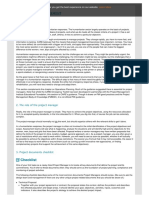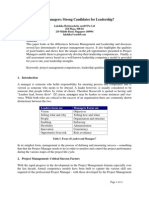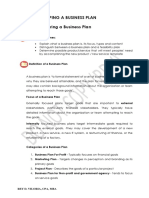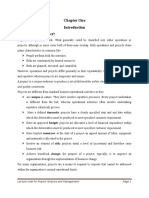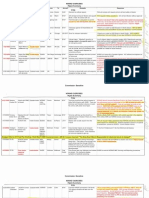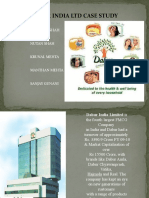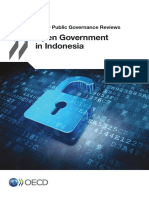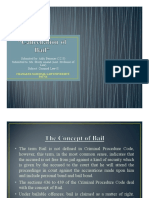Project Charter: John Edward Pangilinan BS Accounting Information System
Project Charter: John Edward Pangilinan BS Accounting Information System
Uploaded by
John Edward PangilinanCopyright:
Available Formats
Project Charter: John Edward Pangilinan BS Accounting Information System
Project Charter: John Edward Pangilinan BS Accounting Information System
Uploaded by
John Edward PangilinanOriginal Description:
Original Title
Copyright
Available Formats
Share this document
Did you find this document useful?
Is this content inappropriate?
Copyright:
Available Formats
Project Charter: John Edward Pangilinan BS Accounting Information System
Project Charter: John Edward Pangilinan BS Accounting Information System
Uploaded by
John Edward PangilinanCopyright:
Available Formats
John Edward Pangilinan
BS Accounting Information System
Project Charter
A project charter is a formal, typically short document that describes your project in its entirety
— including what the objectives are, how it will be carried out, and who the stakeholders are. It
is a crucial ingredient in planning out the project because it is used throughout
the project lifecycle.
Many projects operate without a project charter, even multimillion dollar projects. But the
formal authorization of the project by the performing organization can be important to ensure the
lines of authority are clear and identify what the organization is thinking when creating the
project. I can think of some project issues that could have been avoided if the project manager
and/or sponsor would have created one.
The project charter is the document issued by the project initiator or sponsor that formally
authorizes the existence of a project and provides the project manager with the authority to apply
organizational resources to project activities. It documents the business needs, assumptions,
constraints, the understanding of the customer’s needs and high-level requirements, and the new
product, service, or result that it is intended to satisfy, such as:
1. Project purpose or justification
Stating the business need that the project addresses can give everyone direction and clarity
regarding project decisions and build a foundation of strong leadership from the performing
organization. When everyone knows why the project is being performed, they can be laser
focused on the end result.
2. Measurable project objectives and related success criteria.
A statement of the project’s goals and criteria for success creates a strong statement of what
the company is expecting from the project. It ensures everyone is working toward the same
goal and is clear on what those goals are.
3. High level requirements
There are several components which have a place within the project charter (i.e. above the
project) as well as the project management plan (i.e. within the project). The project
requirements as envisioned by the organization can be placed within the project charter to
make it clear what the organization is thinking by creating the project.
4. Assumptions and constraints
Many project issues arise from unclear assumptions, and many of these assumptions are
clear to the management of the organization before they create the project. Therefore, they
should be stated within the project charter and thereby passed down to the project
management plan.
5. High-level project description and boundaries
A high level scope is generally defined, if not on paper than in executive’s minds, well
before the project becomes a project. Writing this scope into a project charter makes it
crystal clear what the project’s creators are thinking. It should not, however, be considered
a final project scope.
6. High-level risks
Most projects have one or two major risks that define the project. For example a structural
failure for a bridge overpass project, or website payment software that contains security
glitches. These are the risks that are fundamental to the project’s success and are generally
thought about before the project becomes a project. Therefore, they should be included
within the project charter, but they should not take the place of a project risk
analysis within the project management plan.
7. Summary milestone schedule
Most projects have milestones that are defined by executives before the project becomes a
project, whether explicitly stated or implied. For example a mine access road needs to be
completed before construction equipment can move in. These milestones define the project
and should therefore be placed into the project charter, however they do not take the place
of a detailed project schedule during the project planning stage.
8. Summary budget
All projects are created in the context of organizational budget constraints. This context
should be communicated within the project charter in order to pass on the budgetary
constraints into the project planning phase.
9. Stakeholder list
Most projects have one or two major stakeholders that need alot of attention. For example,
a project for a new coal mine that requires a golf course to be moved (a real project of
mine) needs to make sure it works very closely with the golf course. Although the project
charter is not the appropriate place for a comprehensive list of all stakeholders, the ones
that are of primary importance to the project should be identified.
10. Project approval requirements
Because most projects require approval from external authorities, those approvals which
will have a major impact on the project can be explicitly stated within the project charter.
For example, in the mine building project mentioned above, the government approval for
mine construction is so integral to the project that it could be mentioned in the project
charter. The project charter is not the place for a comprehensive list of approval
requirements, however.
11. Assigned project manager
As stated in the PMBOK above, one of the primary purposes of the project charter is to
assign responsibility to the project manager. Therefore, the project manager should be
named and their authority to use organizational resources should be made clear.
12. Project Sponsor
The project sponsor is one level above the project manager, often an organization contact
for the project. They should be named and their responsibilities in regard to the project
made clear.
1. Project Statement of work - A statement of work is a document routinely
employed in the field of project management. It is the narrative description
of a project's work requirement. It defines project-specific activities,
deliverables and timelines for a vendor providing services to the client.
2. Business Case - Information included in a formal business case could be the
background of the project, the expected business benefits, the options
considered (with reasons for rejecting or carrying forward each option), the
expected costs of the project, a gap analysis and the expected risks.
3. Agreements - The project management agreement is the agreement between
the project manager and the employer or owner. The project manager acts as
the agent of the owner and provides the services usually rendered by a
contractor who performs the tasks.
4. Enterprise environmental factors - Enterprise environmental factors are the
influences not under the control of the organization or the project
management team that affect the organization, the project, and its outcome.
Every organization has to exist and work within the EEF. These influences
may have positive or negative impacts on your project constraints, though
often the impact is negative. Enterprise environment factors can be either
internal or external.
5. Organizational Process Assets - Organizational Process Assets are the plans,
processes, policies, procedures, and knowledge bases specific to and used by
the performing organization.
6. Expert Judgement - Expert Judgment is a technique in which judgment is
provided based upon a specific set of criteria and/or expertise that has been
acquired in a specific knowledge area, application area, or product area, a
particular discipline, an industry, etc. Such expertise may be provided by
any group or person with specialized education, knowledge, skill,
experience, or training.
7. Facilitation Techniques - Facilitation techniques involve getting people
together to create new knowledge. As the facilitator, the Project
Manager needs to encourage all ideas, resolve conflicts between contributors
and achieve the goal of the exercise – be it a set of requirements or
a Project Charter.
Say that you are a Project Manager of a consulting company. You are
tasked to create an AIS for Company Y. With this, determine each
stakeholders and define their (a) role, (b) influence over the progress and (c)
relevance to the project.
Good management is achieved through a relevant and timely
information to decision-makers, and other users of accounting information.
Responsibility for the development of the economic entity, the overall
economy and their performance is primarily managers and equally,
accountants and auditors. Obviously, they join the users of accounting
information, which should be responsible for the use of the information they
possess.
Stockholders have the right to know how a company is managing its investments
and has a right to know the new changes in the system and how it will affect the
company routine. They have the power to continue or to stop the operation. They
are the one who supposed to approve the project.
Federal and State Governments require tax returns and other documents often
prepared by accountants
Banks or lending institutions may use accounting information to guide decisions
such as whether to lend or how much to lend a business
Investors will also use accounting information to guide investment decisions
You might also like
- 2 - Project InitiationDocument23 pages2 - Project Initiationibr1234100% (3)
- John Edward Pangilinan Case - Tesco PLC Leveraging Global KnowledgeDocument2 pagesJohn Edward Pangilinan Case - Tesco PLC Leveraging Global KnowledgeJohn Edward PangilinanNo ratings yet
- Case Study No. 2: A. 1.how About You Set About Conducting Such A Review?Document6 pagesCase Study No. 2: A. 1.how About You Set About Conducting Such A Review?rahulNo ratings yet
- Skills and Knowledge Activity BSBPMG511Document8 pagesSkills and Knowledge Activity BSBPMG511Pahn PanrutaiNo ratings yet
- Pub 404 SDocument7 pagesPub 404 SAchileusNo ratings yet
- Project OutlineDocument6 pagesProject OutlinelyleholstNo ratings yet
- Scope Statement Development InstructionsDocument9 pagesScope Statement Development InstructionsSnehal KabraNo ratings yet
- LESSON 6 - Project ImplimentationDocument14 pagesLESSON 6 - Project Implimentationwambualucas74No ratings yet
- Scope Statement Development Instructions 021506125052 Scope Statement Development Instructions 062007Document13 pagesScope Statement Development Instructions 021506125052 Scope Statement Development Instructions 062007filip_1981_2000100% (1)
- 11 Project Management PDFDocument4 pages11 Project Management PDFSaiful Islam SumonNo ratings yet
- Feasibility Study InitiationDocument12 pagesFeasibility Study InitiationSajadur Rashid SabbirNo ratings yet
- Sourav Sasmal ProjectDocument10 pagesSourav Sasmal ProjectSourav SasmalNo ratings yet
- Project Development Evaluation and FeasibilityDocument17 pagesProject Development Evaluation and FeasibilityHamza ZainNo ratings yet
- WP1019 CharterDocument5 pagesWP1019 CharternocnexNo ratings yet
- Lean Six Sigma BB - QuestionnaireDocument18 pagesLean Six Sigma BB - QuestionnaireVasant bhoknalNo ratings yet
- Project Managers: Strong Candidates For Leadership?Document11 pagesProject Managers: Strong Candidates For Leadership?Laks HettNo ratings yet
- Assignment 8Document7 pagesAssignment 8Shanbhag MamataNo ratings yet
- Chapter 2Document37 pagesChapter 2Temesgen ErenaNo ratings yet
- Summary Knowledge v2Document32 pagesSummary Knowledge v2Quang ThangNo ratings yet
- Lecture 02 - PMDocument16 pagesLecture 02 - PMemmanuelmachar5No ratings yet
- Unit 3 & 4 & 5 FinalDocument95 pagesUnit 3 & 4 & 5 Finalkatjinomasa kavetuNo ratings yet
- What Is A Project CharterDocument6 pagesWhat Is A Project CharterManel VazquezNo ratings yet
- Question Bank - Mod-4 MEIT (202-23 ODD)Document22 pagesQuestion Bank - Mod-4 MEIT (202-23 ODD)ranjanNo ratings yet
- Unit 4Document5 pagesUnit 4HENRY MAYAMBUNo ratings yet
- Lecture 3: Project Integration Management: Dr. Saif UllahDocument65 pagesLecture 3: Project Integration Management: Dr. Saif UllahAmeer Hamza Khan DreshakNo ratings yet
- B.4.9. Criteria For Appraisal of The Financial Investment in IS&T ProjectsDocument4 pagesB.4.9. Criteria For Appraisal of The Financial Investment in IS&T Projectsmaga2000No ratings yet
- Project Management NotesDocument82 pagesProject Management NotesLinda Elena PEREZ LARRAHONDONo ratings yet
- Construction Management of A Shipping Container HomeDocument3 pagesConstruction Management of A Shipping Container HomeWajiha MunawwarNo ratings yet
- LECTURE 4 InitiationDocument25 pagesLECTURE 4 InitiationAzeem KhanNo ratings yet
- 15 Project Management Principles You Should KnowDocument8 pages15 Project Management Principles You Should KnowM iqbalNo ratings yet
- Chapter 4 Project Management FinalDocument285 pagesChapter 4 Project Management FinaltesfaNo ratings yet
- Project Charter: Project Title and DescriptionDocument2 pagesProject Charter: Project Title and DescriptionUqba Khan NiaziNo ratings yet
- Cse 495Document10 pagesCse 495Samiha ChowdhuryNo ratings yet
- 1 - Agree Precise Specification (Terms of Reference) For The ProjectDocument10 pages1 - Agree Precise Specification (Terms of Reference) For The ProjectAdil HassanNo ratings yet
- Topic 3Document18 pagesTopic 3onyangorael917No ratings yet
- Chapter 2Document23 pagesChapter 2Ashebir HunegnawNo ratings yet
- SPM Q.BANK All UnitDocument64 pagesSPM Q.BANK All Unitpriyavishwakarma7469310No ratings yet
- Tom Mboya Labor College: DSCM 3: Project and Contracts Management/ DPM 2: Project Procurement ManagementDocument33 pagesTom Mboya Labor College: DSCM 3: Project and Contracts Management/ DPM 2: Project Procurement Managementjoshua omondiNo ratings yet
- 50 Interview Questions For PMPDocument14 pages50 Interview Questions For PMPVinita BhatiaNo ratings yet
- Project Plan: (Instructions)Document13 pagesProject Plan: (Instructions)Santosh NittalaNo ratings yet
- Project ManagementDocument43 pagesProject ManagementMandy RandiNo ratings yet
- Chapter 2Document17 pagesChapter 2Muhammad Zafar100% (1)
- Interview Questions For PMDocument18 pagesInterview Questions For PMshipraa7No ratings yet
- Unit 2Document10 pagesUnit 2Nikita GuptaNo ratings yet
- Life Cycle Phases in Construction ProjectDocument10 pagesLife Cycle Phases in Construction Projectaymanmomani2111No ratings yet
- Asanka - ETC 4262 PROJECT MANAGEMENT ASSIGNMENT 01 PERERA G A N EGT-17-504Document6 pagesAsanka - ETC 4262 PROJECT MANAGEMENT ASSIGNMENT 01 PERERA G A N EGT-17-504buddhikaisuruNo ratings yet
- PM Ut 1Document10 pagesPM Ut 1SarthakNo ratings yet
- Project AnalysisDocument8 pagesProject Analysisrukurukaiya234No ratings yet
- 2002 SolutionDocument9 pages2002 SolutionPriyesh SolkarNo ratings yet
- Chapter 4Document14 pagesChapter 4Sharmila ChaudharyNo ratings yet
- MT - ENGINEERING MANAGEMENT-Integration ManagementDocument5 pagesMT - ENGINEERING MANAGEMENT-Integration Management22101512No ratings yet
- Assignment 11 MaretDocument3 pagesAssignment 11 MaretNaufal MaftukhanNo ratings yet
- Project Planning and Analysis - NotesDocument120 pagesProject Planning and Analysis - Notesshivangi dabasNo ratings yet
- Project Management Procedures4266Document27 pagesProject Management Procedures4266Hamayoun MurtazaNo ratings yet
- 4th Ed - Develop Project CharterDocument8 pages4th Ed - Develop Project CharterKwame Meshack AhinkorahNo ratings yet
- Lesson 1 Preparing A Business PlanDocument6 pagesLesson 1 Preparing A Business PlanRey ViloriaNo ratings yet
- Chapter 01 PMDocument8 pagesChapter 01 PMHayelom Tadesse GebreNo ratings yet
- Unit 8Document25 pagesUnit 8Krushnasamy SuramaniyanNo ratings yet
- Project Management PlanDocument11 pagesProject Management Planexpert 60No ratings yet
- Analyze Your Business Requirements: 2. Search For A VendorDocument3 pagesAnalyze Your Business Requirements: 2. Search For A VendorAnkurNo ratings yet
- Corporate Governance Codes in Major Jurisdictions Across The WorldDocument43 pagesCorporate Governance Codes in Major Jurisdictions Across The WorldJohn Edward PangilinanNo ratings yet
- Functions of Management: Lesson 2Document56 pagesFunctions of Management: Lesson 2John Edward PangilinanNo ratings yet
- Designing Organizationa L Structures: Lesson 3Document58 pagesDesigning Organizationa L Structures: Lesson 3John Edward PangilinanNo ratings yet
- Course Syllabus - Information Systems Security Engineering & Management ReportingDocument1 pageCourse Syllabus - Information Systems Security Engineering & Management ReportingJohn Edward PangilinanNo ratings yet
- The Problem and Its BackgroundDocument59 pagesThe Problem and Its BackgroundJohn Edward PangilinanNo ratings yet
- Schools Division Office of Bataan Sdo Annex Dinalupihan Pita Elementary SchoolDocument27 pagesSchools Division Office of Bataan Sdo Annex Dinalupihan Pita Elementary SchoolJohn Edward PangilinanNo ratings yet
- Summative Test MathematicsDocument4 pagesSummative Test MathematicsJohn Edward PangilinanNo ratings yet
- Summative Test MathematicsDocument4 pagesSummative Test MathematicsJohn Edward PangilinanNo ratings yet
- Erica Mae G. MagsinoDocument2 pagesErica Mae G. MagsinoJohn Edward PangilinanNo ratings yet
- Boutique de Moda: Pangilinan, John Edward RDocument1 pageBoutique de Moda: Pangilinan, John Edward RJohn Edward PangilinanNo ratings yet
- Information System Analysis and DesignDocument43 pagesInformation System Analysis and DesignJohn Edward PangilinanNo ratings yet
- Orca Share Media1601367041808 6716620188926428611Document38 pagesOrca Share Media1601367041808 6716620188926428611John Edward PangilinanNo ratings yet
- Information System Analysis and DesignDocument41 pagesInformation System Analysis and DesignJohn Edward PangilinanNo ratings yet
- Modular Distance Learning: Department of EducationDocument2 pagesModular Distance Learning: Department of EducationJohn Edward PangilinanNo ratings yet
- John Edward Pangilinan BS Accounting Information SystemDocument5 pagesJohn Edward Pangilinan BS Accounting Information SystemJohn Edward PangilinanNo ratings yet
- Module 4 PresentationDocument45 pagesModule 4 PresentationJohn Edward Pangilinan100% (11)
- RemindersDocument2 pagesRemindersJohn Edward PangilinanNo ratings yet
- 21 Century Activity Name:Bea Leonor Pangilinan Date: September 4,2020 Year/Section:GAS 12 Temperance ScoreDocument2 pages21 Century Activity Name:Bea Leonor Pangilinan Date: September 4,2020 Year/Section:GAS 12 Temperance ScoreJohn Edward PangilinanNo ratings yet
- Family TreeDocument1 pageFamily TreeJohn Edward PangilinanNo ratings yet
- Design of Home Security System Prototype For Users Using LabviewDocument11 pagesDesign of Home Security System Prototype For Users Using LabviewHruthika ReddyNo ratings yet
- KMU Vs Garcia (FC)Document11 pagesKMU Vs Garcia (FC)abbyNo ratings yet
- Popular Magazines in KeralaDocument11 pagesPopular Magazines in Keralababithamarina100% (1)
- IET Control Theory and ApplicationsDocument6 pagesIET Control Theory and ApplicationsПи ЛотNo ratings yet
- Consumer Protection Act: Tushar Swami (609) Reshma Patil (610) Sarvesh Raj Singh (611) Sunket Anand PantDocument41 pagesConsumer Protection Act: Tushar Swami (609) Reshma Patil (610) Sarvesh Raj Singh (611) Sunket Anand PantsakshiNo ratings yet
- NORAD Exercises Hijack SummaryDocument4 pagesNORAD Exercises Hijack Summary9/11 Document Archive80% (10)
- D 04687 HighDocument1 pageD 04687 HighpolitixNo ratings yet
- Urban Growth Territorial and Social ReorganizationDocument19 pagesUrban Growth Territorial and Social ReorganizationYongliang LiuNo ratings yet
- Sharif Mohammad Masudul Hossain: EmailDocument3 pagesSharif Mohammad Masudul Hossain: Emailanon_816894No ratings yet
- Rmo 19-2007Document22 pagesRmo 19-2007ACVGNo ratings yet
- Starbucks Case - PlanningDocument11 pagesStarbucks Case - PlanningHuy Thông100% (1)
- Marketing Information System & Marketing ResearchDocument30 pagesMarketing Information System & Marketing ResearchDr.vikas GoyaNo ratings yet
- Lesson Plan in Mapeh 9 I. Objectives: Nov. 21-23, 2018 Gold 10:00-11:00 Am Mercury 1:00-2:00pmDocument4 pagesLesson Plan in Mapeh 9 I. Objectives: Nov. 21-23, 2018 Gold 10:00-11:00 Am Mercury 1:00-2:00pmJayselTampusVillaroNo ratings yet
- 2012 ASCE Los Angeles Infrastructure Report CardDocument28 pages2012 ASCE Los Angeles Infrastructure Report CardSouthern California Public RadioNo ratings yet
- Consumer Behaviour MM-4Document19 pagesConsumer Behaviour MM-4anujbeniwalNo ratings yet
- Role of Social Media in Education: A Teachers' Perspective: December 2017Document8 pagesRole of Social Media in Education: A Teachers' Perspective: December 2017Andreea StoicaNo ratings yet
- ARTH 266 AssignmentsDocument4 pagesARTH 266 AssignmentsRasha GaberNo ratings yet
- Grammar #1: Systemic Functional Grammar. Chapter #1)Document3 pagesGrammar #1: Systemic Functional Grammar. Chapter #1)Daniela Milagros Acosta EspinaNo ratings yet
- General Spec For Pipline Riser DesignDocument3 pagesGeneral Spec For Pipline Riser Designanishsr100% (1)
- Yoga Unit RubricsDocument3 pagesYoga Unit Rubricsapi-245820768No ratings yet
- Dabur India LTD Case StudyDocument13 pagesDabur India LTD Case Studynutan_shah89No ratings yet
- Open Government in Indonesia: OECD Public Governance ReviewsDocument324 pagesOpen Government in Indonesia: OECD Public Governance ReviewsKresna Aria LatiefNo ratings yet
- 2F Community Health Nursing Process NotesDocument11 pages2F Community Health Nursing Process NotesCAUSIN, Lance Matthew,No ratings yet
- Cancellation of BailsDocument8 pagesCancellation of BailsAditi BanerjeeNo ratings yet
- Toolbox Talks: Fire PreventionDocument3 pagesToolbox Talks: Fire PreventionshafieNo ratings yet
- Cemetery Rules & Regulations - Webster United Church of ChristDocument3 pagesCemetery Rules & Regulations - Webster United Church of Christhazel marie pejano jacaNo ratings yet
- 4.Model-Questionnaire Reliance RetailDocument6 pages4.Model-Questionnaire Reliance RetailARYA GOWDANo ratings yet
- ACAS Code - Disciplinary - Procedures PDFDocument20 pagesACAS Code - Disciplinary - Procedures PDFCristianNo ratings yet
- M1906 Heet General Management Project ReportDocument65 pagesM1906 Heet General Management Project ReportSatish WagholeNo ratings yet
- C15 Community ImmersionDocument23 pagesC15 Community ImmersionDivineNo ratings yet









